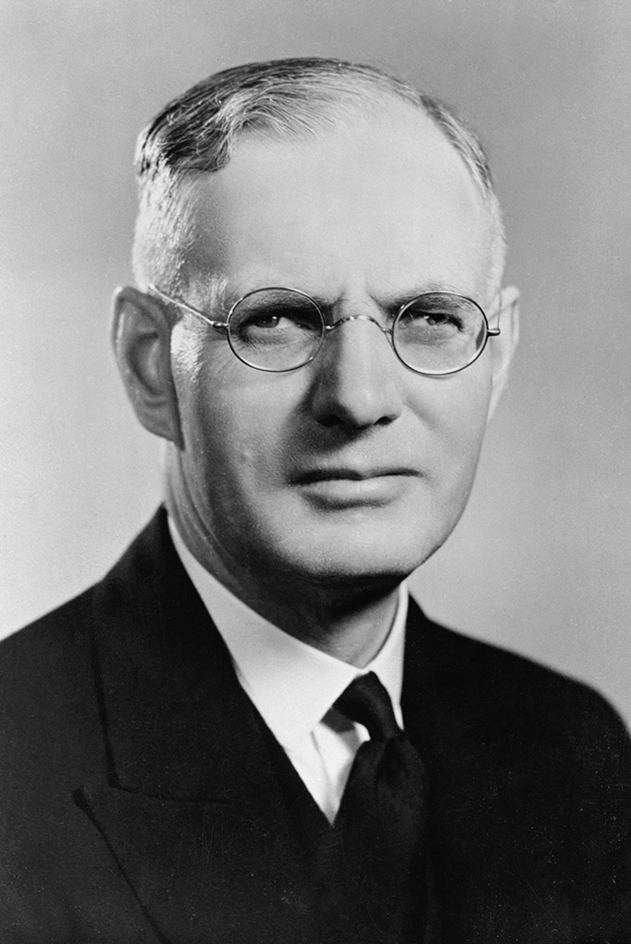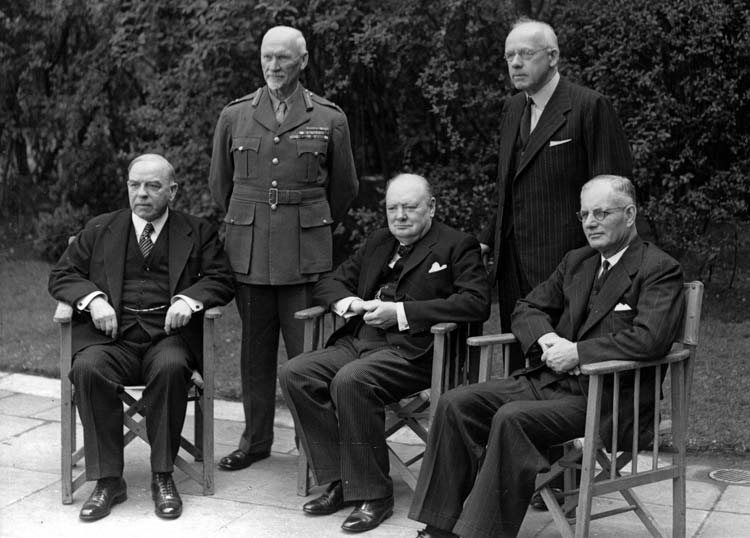Curtin, John Joseph (1885-1945), served as prime minister of Australia from 1941 until his death in 1945. Curtin, a member of the Australian Labor Party (ALP), held office during the critical years of World War II (1939-1945). He united the nation behind the war effort, and he introduced a limited form of conscription (military draft) even though his party traditionally opposed it. Curtin was the first Australian prime minister to have represented a Western Australian seat (Fremantle) in the House of Representatives. Curtin is widely respected for his leadership during the war, for protecting his country’s interests, and for preparing Australia’s postwar development.

Early life and family
John Joseph Ambrose Curtin was born in Creswick, Victoria, on Jan. 8, 1885. He was the eldest son of Irish immigrants John Curtin and Catherine Bourke Curtin. His father suffered from poor health, and young John grew up in the Melbourne suburb of Brunswick under increasingly impoverished circumstances. He left school at age 13 to help support his family. Curtin worked a series of day jobs, settling as a clerk with the Titan Manufacturing Company in 1903. By night, Curtin studied political, philosophical, and literary works at the public library.
Labor movement leader
In 1901, before Curtin was old enough to vote, he joined the Political Labor Council, which would eventually become the ALP in Victoria. Curtin also joined the more radical Victorian Socialist Party and served as its secretary. In 1911, he became secretary of the Victorian Timber Workers Union. In this position, he fought for better working and living conditions and for improved workers’ compensation.
In 1912, Curtin went to Hobart, Tasmania, in connection with his work for the Victorian Timber Workers Union. There he met Abraham Needham, who owned a sign-painting business and was a prominent Australian socialist. Curtin also met Needham’s daughter, Elsie Needham (1890-1975), who kept the accounts for her father’s business.
Curtin opposed Australia’s participation in World War I (1914-1918) and was a key activist in the movement against military conscription. In July 1916, he was hospitalized for a steadily worsening addiction to alcohol. In December of that same year, Curtin was jailed for three days for refusing to register for military service.
In February 1917, Curtin was appointed editor of the Westralian Worker, a Perth weekly newspaper owned at the time by the Australian Workers Union. On April 21, 1917, John Curtin and Elsie Needham married in Perth. The couple had two children, Elsie Milda (1917-2009) and John Francis (1921-2007). The Curtins moved to Cottesloe, a seaside suburb of Perth, in 1923.
Curtin quickly became a leading figure in the labor movement in Western Australia. From 1920 to 1925, he was also president of the Western Australian district of the Australian Journalists’ Association. In June 1924, Curtin was a labor movement representative at the International Labour Conference in Geneva, Switzerland. The conference is the annual policymaking meeting of the International Labour Organization, which promotes the welfare of workers.
Curtin first ran for a seat in the Australian House of Representatives in 1914. He was unsuccessful, but he used his election bid as a platform for his political ideas. He ran and lost again in 1919 and in 1925. On Nov. 17, 1928, Curtin finally won a seat in the House. However, the onset of the Great Depression—a worldwide economic slump that began in 1929, just as the ALP came to power—dashed any hopes of reform, and the ALP split over its response to the crisis. By the beginning of 1932, the Labor government had fallen and Curtin was back in Perth writing articles for the Westralian Worker.
Prime minister
In 1934, Curtin again won a seat in the House, and in 1935, he was elected leader of the ALP. As the world moved closer to war in the late 1930’s, Curtin at first favored an isolationist policy—that is, he believed Australia should take little part in world affairs. Eventually, however, he came to support Australia’s participation in the conflict while still arguing against conscription. As the war with Germany began to escalate, so did Curtin’s influence in federal politics. In October 1940, he and two other ALP members joined the new Advisory War Council, a body formed to include all the major political parties in Parliament into the process of making decisions about the war effort.

On Oct. 3, 1941, the government headed by Prime Minister Arthur Fadden of the Country Party lost an important budget vote in the House, and Fadden resigned. The Country Party, a forerunner of today’s Nationals, represented the interests of farmers and other rural Australians. After Fadden’s resignation, the governor general asked Curtin and the ALP to form a government. Curtin was sworn in as prime minister and minister for defense on October 7.
World War II.
Two months after his swearing in, on the morning of December 8, Curtin learned of the Japanese attack on the United States naval base at Pearl Harbor in Hawaii. Australia independently declared war on Japan. In 1939, Australia had declared war against Germany as the result of a declaration of war by the United Kingdom.
Japanese troops quickly invaded the island of New Guinea, north of Australia, and Japanese warplanes bombed the Australian city of Darwin. As Australia faced a serious threat of invasion, Curtin was forced to institute the military conscription that he had always so strongly opposed, though overseas service of draftees remained restricted to a zone just to the north of Australia.
Curtin worked closely with the United States to strengthen Australian resolve. He agreed to the appointment of American General Douglas MacArthur as supreme commander of the Southwest Pacific Area—a command that included the home defenses of Australia. With a radio broadcast on March 14, 1942, Curtin became the first Australian prime minister to address the American people. He referred to his nation as “the last bastion between the west coast of America and the Japanese. If Australia goes, the Americas are wide open.” In the following months, Allied victories over the Japanese at the battles of Midway and the Coral Sea effectively removed the threat of a Japanese invasion of Australia.

On the home front, Curtin was forced to institute clothing and food rationing while also raising taxes on alcohol, tobacco, and entertainment products. He shifted income taxation powers from the states to the Commonwealth, and his government initiated ambitious postwar reconstruction schemes. He also created an expanded range of social services, such as pensions for war widows, unemployment benefits, and sickness benefits. He lowered the voting age to 18 for those who had served in the armed forces outside Australia. He also introduced a number of policies to guide postwar reconstruction.
Curtin’s administration also enacted the Australian Broadcasting Act of 1942, which provided for government regulation of commercial broadcasting. The Women’s Employment Act of 1942 allowed women to take jobs previously held by men and set terms for their employment. A banking act gave the government the power to control interest rates. Other important legislation during Curtin’s administration provided subsidies to dairy farmers and enacted government regulation of the dairy industry.
On Aug. 21, 1943, Curtin and the ALP easily won reelection, increasing their share of the 74 seats of the House of Representatives from 36 to 49. Curtin soon began reinforcing his ties to the United Kingdom and planning for a postwar world. He strongly supported the creation of an international security organization to replace the League of Nations. That new organization would eventually become the United Nations.
The final months.
As World War II drew to a close, Curtin’s health began to worsen. From November 1944 to January 1945, he was hospitalized in Melbourne for heart trouble. After another hospital stay in April, Curtin returned to The Lodge, the prime minister’s residence in Canberra. He died in the prime ministerial bedroom on July 5, 1945. He was the second Australian prime minister to die in office. His body was flown to Perth and buried in Karrakatta Cemetery before a crowd of thousands.
Curtin’s deputy, Francis Forde, took on Curtin’s post for one week—the shortest term for any Australian prime minister. On July 12, 1945, the ALP elected Ben Chifley to the leadership, and Chifley’s government was sworn in the next day.
